Submarine Small-Scale Features of Cyclic Steps in the Penghu Canyon: Implications for the Migration of Canyon
Abstract
:1. Introduction
2. Geological Setting
3. Data and Methods
4. Geometric Features of Submarine Geomorphology
4.1. Geomorphic Features of the Penghu Canyon
4.2. Cyclic Steps and Sediment Wave in the Penghu Canyon
5. Results and Discussion
5.1. Formation Pattern of Cyclic Steps
5.2. Evolution and Migration of the Penghu Canyon
6. Conclusions
- (1)
- Six cyclic steps (CS1–CS6) indicate with the crescent-shape and upstream-migration in the Penghu canyon. The wavelengths of the CS1–CS6 vary from 1 to 6 km and wave heights are ranged from 19 to 81 m. They represent the net-erosional type according to the geometry features of cyclic steps;
- (2)
- Based on the location and geometry of the CS1–CS6 at the junction of Penghu canyon and Taiwan canyon, the formation of the CS1–CS6 is caused by turbidity currents along two canyons. The CS1–CS6 are formed by rapid erosion under scouring turbidity current along the lower section of the canyon; and
- (3)
- The occurrence of the CS1–CS6 in the canyon suggests that the Penghu canyon is an active canyon at the evolution stage. During the active stage of the canyon, cyclic steps destroy the canyon wall and may promote the migration of the canyon.
Author Contributions
Funding
Institutional Review Board Statement
Informed Consent Statement
Data Availability Statement
Acknowledgments
Conflicts of Interest
References
- Paull, C.K.; Caress, D.W.; Ussler, W.; Lundsten, E.; Thomas, H. Axial channel morphology fill and movement within submarine canyons off California. In AGU Fall Meeting Abstracts; 2008; abs. OS54A-01; Available online: https://ui.adsabs.harvard.edu/abs/2008EOSTr..89..493J/abstract (accessed on 9 August 2022).
- Gong, C.L.; Wang, Y.M.; Peng, X.C.; Li, W.G.; Qiu, Y.; Xu, S. Sediment waves on the South China Sea slope off southwestern Taiwan: Implications for the intrusion of the Northern Pacific Deep Water into the South China Sea. Mar. Petrol. Geol. 2012, 32, 95–109. [Google Scholar] [CrossRef]
- Hsiung, K.H.; Yu, H.S. Sediment dispersal system in the Taiwan–South China Sea collision zone along a convergent margin: A comparison with the Papua New Guinea collision zone of the western Solomon Sea. J. Asian Earth Sci. 2013, 62, 295–307. [Google Scholar] [CrossRef]
- Parker, G.; Izumi, N. Purely erosional cyclic and solitary steps created by flow over a cohesive bed. J. Fluid. Mech. 2000, 419, 203–238. [Google Scholar] [CrossRef]
- Smith, D.P.; Ruiz, G.; Kvitek, R.; Iampietro, P.J. Semi-annual patterns of erosion and deposition in Upper Monterey Canyon from serial multibeam bathymetry. Geol. Soc. Am. Bull. 2005, 117, 1123–1133. [Google Scholar] [CrossRef]
- Smith, D.P.; Kvitek, R.; Ruiz, G.; Iampietro, P.J.; Wong, K. Twenty-nine months of geomorphic change in upper Monterey Canyon (2002–2005). Mar. Geol. 2007, 236, 79–94. [Google Scholar] [CrossRef]
- Xu, J.P.; Wong, F.L.; Kvitek, R.; Smith, D.; Paull, C.K. Sand-wave migration in Monterey Submarine Canyon, central California. Mar. Geol. 2008, 248, 193–212. [Google Scholar] [CrossRef]
- Paull, C.K.; Caress, D.W.; Ussler, W., III; Lundsten, E.; Meiner-Johnson, M. High-resolution bathymetry of the axial channels within Monterey and Soquel submarine canyons, offshore central California. Geosphere 2015, 7, 1077–1101. [Google Scholar] [CrossRef]
- Zhong, G.F.; Cartigny, M.J.B.; Kuang, Z.G.; Wang, L.L. Cyclic steps along the South Taiwan Shoal and West Penghu submarine canyons on the northeastern continental slope of the South China Sea. Geol. Soc. Am. Bull. 2015, 127, 804–824. [Google Scholar] [CrossRef]
- Pierdomenico, M.; Casalbore, D.; Chiocci, F.L. The key role of canyons in funnelling litter to the deep sea: A study of the Gioia Canyon (Southern Tyrrhenian Sea). Anthropocene 2020, 30, 100237. [Google Scholar] [CrossRef]
- Sømme, T.O.; Helland, H.W.; Martinsen, O.J. Relationships between morphological and sedimentological parameters in source-to-sink systems: A basis for predicting semi-quantitative characteristics in subsurface systems. Basin Res. 2009, 21, 361–387. [Google Scholar] [CrossRef]
- Shanmugam, G. 50 years of the turbidite paradigm (1950s–1990s): Deep-water processes and facies models-acritical perspective. Mar. Petrol. Geol. 2000, 17, 285–342. [Google Scholar] [CrossRef]
- Hasiotis, T.; Papatheodorou, G.; Ferentions, G. A high-resolution approach in the recent sedimentation processes at the head of Zakynthos Canyon, western Greece. Mar. Geol. 2005, 214, 49–73. [Google Scholar] [CrossRef]
- Li, S.J.; Chu, F.Y.; Fang, Y.X.; Wu, Z.Y. Associated interpretation of sub-bottom and single-channel seismic profiles from Shenhu area in the north slope of South China Sea-characteristic of gas hydrate sediment. J. Trop. Oceanogr. 2012, 29, 56–62. [Google Scholar]
- Li, S.; Li, W.; Alves, T.M.; Wang, J.; Wu, S. Large-scale scours formed by supercritical turbidity currents along the full length of a submarine canyon, northeast South China Sea. Mar. Geol. 2020, 424, 106158. [Google Scholar] [CrossRef]
- Wang, Y.B.; Wu, Z.Y.; Shang, J.H.; Yin, S.R.; Zhou, J.Q. Morphologic characteristics and controlling factors of the northeastern South China Sea canyon group. Acta. Oceanol. Sin. 2020, 42, 62–74. [Google Scholar] [CrossRef]
- Ding, W.; Li, J.; Li, J. Morphotectonics and evolutionary controls on the Pearl River Canyon system, South China Sea. Mar. Geophys. Res. 2013, 34, 221–238. [Google Scholar] [CrossRef]
- Ou, X.L.; Zhu, J.J.; Li, S.Z.; Jia, Y.G.; Jia, Z.J.; Zhang, S.S.; Zhang, S.Y.; Chen, R.X.; Chen, X.Q.; Ding, D.; et al. Submarine geomorphological features and their origins analyzed from multibeam bathymetry data in the South China Sea. J. Mar. Sci. Eng. 2021, 9, 1419. [Google Scholar] [CrossRef]
- Zhao, Z.; Klemas, V.; Zheng, Q.; Yan, X. Remote sensing evidence for baroclinic tide origin of internal solitary waves in the northeastern South China Sea. Geophys. Res. Lett. 2004, 31, L06302. [Google Scholar] [CrossRef]
- Qu, T.D.; Girton, J.B.; Whitehead, J.A. Deepwater overflow through Luzon Strait. J. Geophys. Res. 2006, 111, C01002. [Google Scholar] [CrossRef]
- Wang, G.H.; Xie, S.P.; Qu, T.D.; Huang, R.X. Deep South China Sea circulation. Geophys. Res. Lett. 2011, 38, L05601. [Google Scholar] [CrossRef]
- Zhao, W.; Zhou, C.; Tian, J.W.; Yang, Q.X.; Wang, B.; Xie, L.L.; Qu, T.D. Deep water circulation in the Luzon Strait. J. Geophys. Res. Oceans 2014, 119, 790–804. [Google Scholar] [CrossRef]
- Liu, Z.; Zhao, Y.; Colin, C.; Stattegger, K.; Wiesner, M.G.; Huh, C.-A.; Zhang, Y.; Li, X.; Sompongchaiyakul, P.; You, C.-F.; et al. Source-to-sink transport processes of fluvial sediments in the South China Sea. Earth-Sci. Rev. 2016, 153, 238–273. [Google Scholar] [CrossRef]
- Xu, Z.; Wang, Y.; Liu, Z.; McWilliams, J.C.; Gan, J. Insight into the dynamics of the radiating internal tide associated with the Kuroshio Current. J. Geophys. Res. Ocean. 2021, 126, e2020JC017018. [Google Scholar] [CrossRef]
- Parker, G. Interaction between basic research and applied engineering: A personal perspective. J. Hydraul. Res. 1996, 34, 291–316. [Google Scholar] [CrossRef]
- Wang, D.W.; Bai, H.X.; Wu, S.G. The research progress of turbidity currents and related deep-water bedforms. Adv. Earth Sci. 2018, 33, 52–65. [Google Scholar] [CrossRef]
- Fildani, A.; Normark, W.R.; Kostic, S.; Parker, G. Channel formation by flow stripping: Large-scale scour features along the Monterey East Channel and their relation to sediment waves. Sedimentology 2006, 53, 1265–1287. [Google Scholar] [CrossRef]
- Covault, J.A.; Kostic, S.; Paull, C.K.; Ryan, H.F.; Fildani, A. Submarine channel initiation, filling and maintenance from seafloor geomorphology and morphodynamic modelling of cyclic steps. Sedimentology. 2014, 61, 1031–1054. [Google Scholar] [CrossRef]
- Migeon, S.; Savoye, B.; Faugeres, J.C. Quaternary development of migrating sediment waves in the Var deep-sea fan: Distribution, growth pattern, and implication for levee evolution. Sediment. Geol. 2000, 133, 265–293. [Google Scholar] [CrossRef]
- Kostic, S. Modeling of submarine cyclic steps: Controls on their formation, migration, and architecture. Geosphere 2011, 7, 294–304. [Google Scholar] [CrossRef]
- Kuang, Z.G.; Zhong, G.F.; Wang, L.L.; Wang, L.L.; Guo, Y.Q. Channel-related sediment waves on the eastern slope offshore Dongsha Islands, northern South China Sea. J. Asian Earth. Sci. 2014, 79, 540–551. [Google Scholar] [CrossRef]
- Ding, W.W.; Li, J.B.; Han, X.Q.; Li, M.B.; Suess, E. Geomorphology, grain-size charicteristics, matter source and forming mechanism of sediment waves on the ocean bottom of the northeast South China Sea. Acta. Oceanol. Sin. 2010, 32, 96–105. [Google Scholar]
- Zhu, M.Z.; Graham, S.; Pang, X.; Mchargue, T. Characteristics of migrating submarine canyons from the middle Miocene to present: Implications for paleoceanographic circulation, northern South China Sea. Mar. Petrol. Geol. 2010, 27, 307–319. [Google Scholar] [CrossRef]
- Baztan, J.; Berné, S.; Olivet, J.L.; Rabineau, M.; Aslanian, D.; Gaudin, M. Axial incision: The key to understand submarine canyon evolution (in the western Gulf of Lion). Mar. Pet. Geol. 2005, 22, 805–826. [Google Scholar] [CrossRef]
- Tapponnier, P.; Peltzer, G.; Dain, A.; Armijo, R.; Cobbold, P. Propagating extrusion tectonics in Asia: New insights from simple experiments with plasticine. Geology 1982, 10, 611. [Google Scholar] [CrossRef]
- Taylor, B.; Hayes, D.E. Origin and History of the South China Sea Basin; Geophysical Monograph Series; American Geophysical Union: Washington, DC, USA, 1983; Volume 27, pp. 23–56. [Google Scholar]
- Mishra, O.P. Lithospheric heterogeneities of northeast (NE) India and Indo-Burma region: Geodynamical implications. Geosyst. Geoenviron. 2022, in press. [CrossRef]
- Yu, S.B.; Kuo, L.C.; Punongbayan, R.S.; Ramos, E.G. GPS observation of crustal deformation in the Taiwan–Luzon region. Geophys. Res. Lett. 1999, 26, 923–926. [Google Scholar] [CrossRef]
- He, Y.; Zhong, G.; Wang, L. Characteristics and occurrence of submarine canyon-associated landslides in the middle of the northern continental slope, South China Sea. Mar. Petrol. Geol. 2014, 57, 546–560. [Google Scholar] [CrossRef]
- Zhong, G.F.; Liang, J.Q.; Guo, Y.Q.; Kuang, Z.; Su, P.; Lin, L. Integrated corelog facies analysis and depositional model of the gas hydrate-bearing sediments in the northeastern continental slope, South China Sea. Mar. Petrol. Geol. 2017, 86, 1159–1172. [Google Scholar] [CrossRef]
- Zhu, J.J.; Li, S.Z.; Jia, Y.G.; Zhang, S.Y.; Chen, X.Q.; Chen, R.X.; Suo, Y.H.; Cao, X.Z.; Jia, Z.J.; Ou, X.L.; et al. Links of high velocity anomalies in the mantle to the Proto-South China Sea slabs: Tomography-based review and perspective. Earth-Sci. Rev. 2022, 231, 0012–8252. [Google Scholar] [CrossRef]
- Li, C.-F.; Xu, X.; Lin, J.; Sun, Z.; Zhu, J.; Yao, Y.; Zhao, X.; Liu, Q.; Kulhanek, D.K.; Wang, J. Ages and magnetic structures of the South China Sea constrained by deep tow magnetic surveys and IODP Expedition 349. Geochem. Geophys. Geosyst. 2014, 15, 4958–4983. [Google Scholar] [CrossRef]
- Zhu, J.; Xu, H.; Qiu, X.; Ye, S.; Li, S. Crustal structure and rifting of the northern South China Sea margin: Evidence from shoreline-crossing seismic investigations. Geol. J. 2018, 53, 2065–2083. [Google Scholar] [CrossRef]
- Zhu, J.; Qiu, X.; Kopp, H.; Xu, H.; Sun, Z.; Ruan, A.; Sun, J.; Wei, X. Shallow anatomy of a continent-ocean transition zone in the northern South China Sea from multichannel seismic data. Tectonophysics 2012, 554–557, 18–29. [Google Scholar] [CrossRef]
- Zhang, Y.W.; Liu, Z.F.; Zhao, Y.L.; Colin, C.; Zhang, X.; Wang, M.; Kneller, B. Long-term in situ observations on typhoon-triggered turbidity currents in the deep sea. Geology 2018, 46, 675–678. [Google Scholar] [CrossRef]
- Wessel, P.; Luis, J.F.; Uieda, L.; Scharroo, R.; Wobbe, F.; Smith, W.H.F.; Tian, D. The generic mapping tools version 6. Geochemistry, Geophysics, Geosystems 2019, 20, 5556–5564. [Google Scholar] [CrossRef]
- Lin, A.T.; Watts, A.B.; Hesselbo, S.P. Cenozoic stratigraphy and subsidence history of the South China Sea margin in the Taiwan region. Basin Res. 2003, 15, 453–478. [Google Scholar] [CrossRef]
- Wang, C.S.; Zhu, J.; Zhao, D.D.; Yang, G.M.; Xiong, Z.X.; Zhang, S.S.; Li, S.Z.; JIA, Y.G. Origin and evolution of submarine canyons. Mar. Geol. Front. 2021, 37, 1–15. [Google Scholar] [CrossRef]
- Damuth, J.E. Migrating sediment waves created by turbidity currents in the northern South China Basin. Geology 1979, 7, 520–523. [Google Scholar] [CrossRef]
- Wang, H.; Wang, Y.; Qiu, Y.; Peng, X.; Huang, Q. Development and its tectonic activity ’s origin of turbidity current sediment wave in Manila Trench, the South China Sea. Acta Sedimentol. Sin. 2008, 26, 39–45. (In Chinese) [Google Scholar]
- Lin, C.C.; Lin, T.S.; Liu, C.S.; Horng, C.S.; Wang, Y. Canyon-infilling and gas hydrate occurrences in the frontal fold of the offshore accretionary wedge off southern Taiwan. Mar. Geophys. Res. 2014, 35, 21–35. [Google Scholar] [CrossRef]
- Zhang, Z.; Zhao, W.; Tian, J.; Liang, X. A mesoscale eddy pair southwest of Taiwan and its influence on deep circulation. J. Geophys. Res.-Oceans 2013, 118, 6479–6494. [Google Scholar] [CrossRef]
- Zhang, Y.; Liu, Z.; Zhao, Y.; Wang, W.G.; Li, J.R.; Xu, J.P. Mesoscale eddies transport deep-sea sediments. Sci. Rep. 2014, 4, 5937. [Google Scholar] [CrossRef]
- Tian, J.W.; Yang, Q.X.; Liang, X.F.; Xie, L.L.; Hu, D.X.; Wang, F.; Qu, T.D. Observation of Luzon Strait transport. Geophys. Res. Lett. 2006, 33, 19. [Google Scholar] [CrossRef]
- Yang, Q.X.; Tian, J.W.; Zhao, W. Observation of Luzon Strait transport in summer 2007. Deep Sea Res. Part I Oceanogr. Res. Pap. 2010, 57, 670–676. [Google Scholar] [CrossRef]
- De Leeuw, J.; Eggenhuisen, J.T.; Cartigny, M.J.B. Morphodynamics of submarine channel inception revealed by new experimental approach. Nat. Commun. 2016, 7, 10886. [Google Scholar] [CrossRef]
- Pohl, F.; Eggenhuisen, J.T.; Tilston, M.; Cartigny, M.J.B. New flow relaxation mechanism explains scour fields at the end of submarine channels. Nat. Commun. 2019, 10, 4425. [Google Scholar] [CrossRef] [PubMed]
- Liu, Z.; Chen, R.X.; Zhu, Y.S.; Zhang, G.X.; Dong, D.X. Geophysical studies of mass transport deposits on the slope canyon floor with high-resolution autonomous underwater vehicle (AUV) in the Shenhu area and its implications for sediment transportation. Mar. Geol. Quat. Geol. 2021, 41, 13–21. [Google Scholar]
- Meiburg, E.; Kneller, B. Turbidity currents and their deposits. Annu. Rev. Fluid. Mech. 2010, 42, 135–156. [Google Scholar] [CrossRef]
- Cartigny, M.; Ventra, D.; Postma, G.; Van, D.; Venditti, J. Morphodynamics and sedimentary structures of bedforms under supercritical-flow conditions: New insights from flume experiments. Sedimentology 2014, 6, 712–748. [Google Scholar] [CrossRef]
- Kostic, S.; Parker, G. The response of turbidity currents to a canyon-fan transition: Internal hydraulic jumps and depositional signatures. J. Hydraul. Res. 2006, 44, 631–653. [Google Scholar] [CrossRef]
- Yu, H.S.; Hong, E. Shifting submarine canyons and development of a foreland basin in SW Taiwan: Controls of foreland sedimentation and longitudinal sediment transport. J. Asian Earth Sci. 2006, 27, 922–932. [Google Scholar] [CrossRef]
- Cai, S.; Xie, J.; He, J. An overview of internal solitary waves in the South China Sea. Surv. Geophys. 2012, 33, 927–943. [Google Scholar] [CrossRef]
- Cai, S.Q.; Xie, J.X.; Xu, J.X.; Wang, D.X.; Chen, Z.W.; Deng, X.D.; Long, X.M. Monthly variation of some parameters about internal solitary waves in the South China Sea. Deep Sea Res. Part I Oceanogr. Res. Pap. 2014, 84, 73–85. [Google Scholar] [CrossRef]
- Alford, M.; Peacock, T.; MacKinnon, J. The formation and fate of internal waves in the South China Sea. Nature 2015, 521, 65–69. [Google Scholar] [CrossRef]
- Tian, J.W.; Yang, Q.X.; Zhao, W. Enhanced diapycnal mixing in the South China Sea. J. Phys. Oceanogr. 2009, 39, 3191–3203. [Google Scholar] [CrossRef]
- Normark, W.R.; Piper, D.J.; Romans, B.W.; Covault, J.A.; Dartnell, P.; Sliter, R.W. Submarine canyon and fan systems of the California continental borderland. Geol. Soc. Am. Spec. Pap. 2009, 454, 141–168. [Google Scholar]
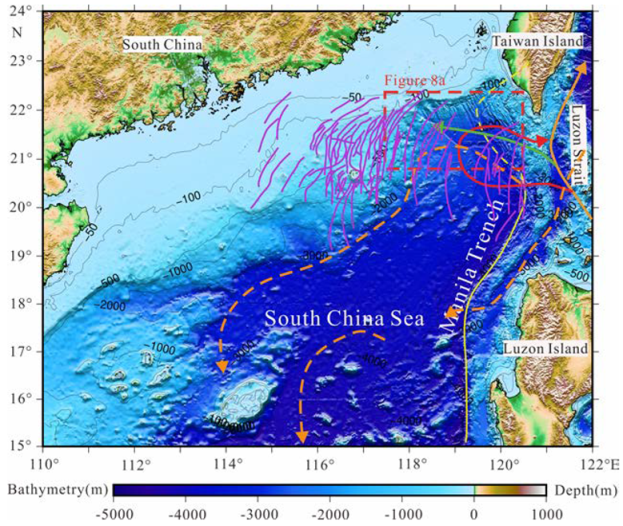

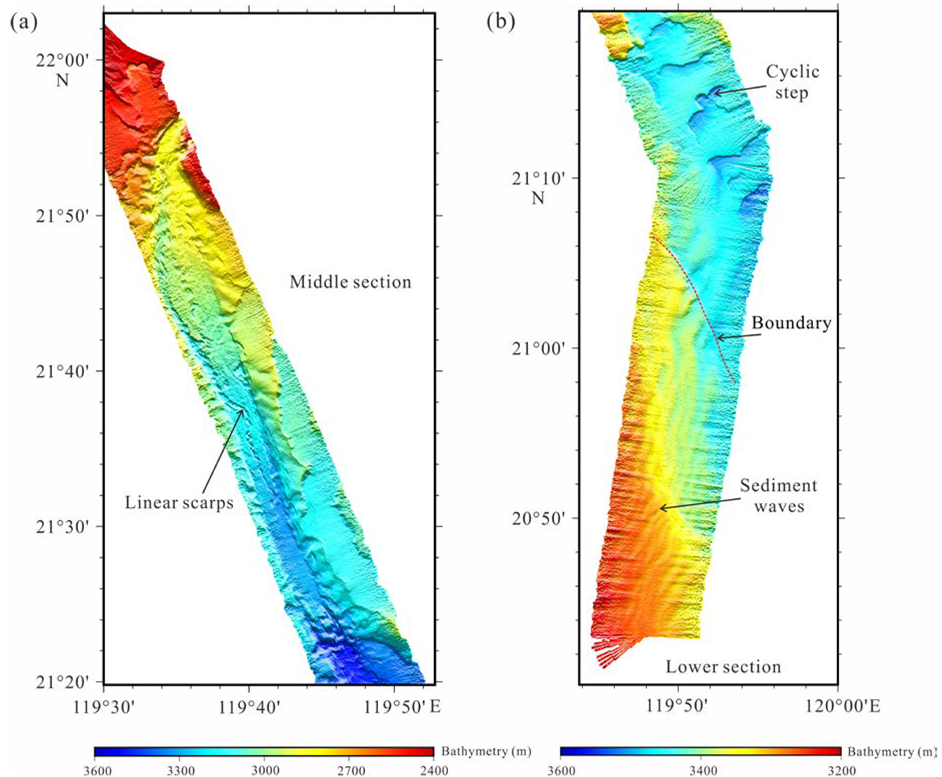
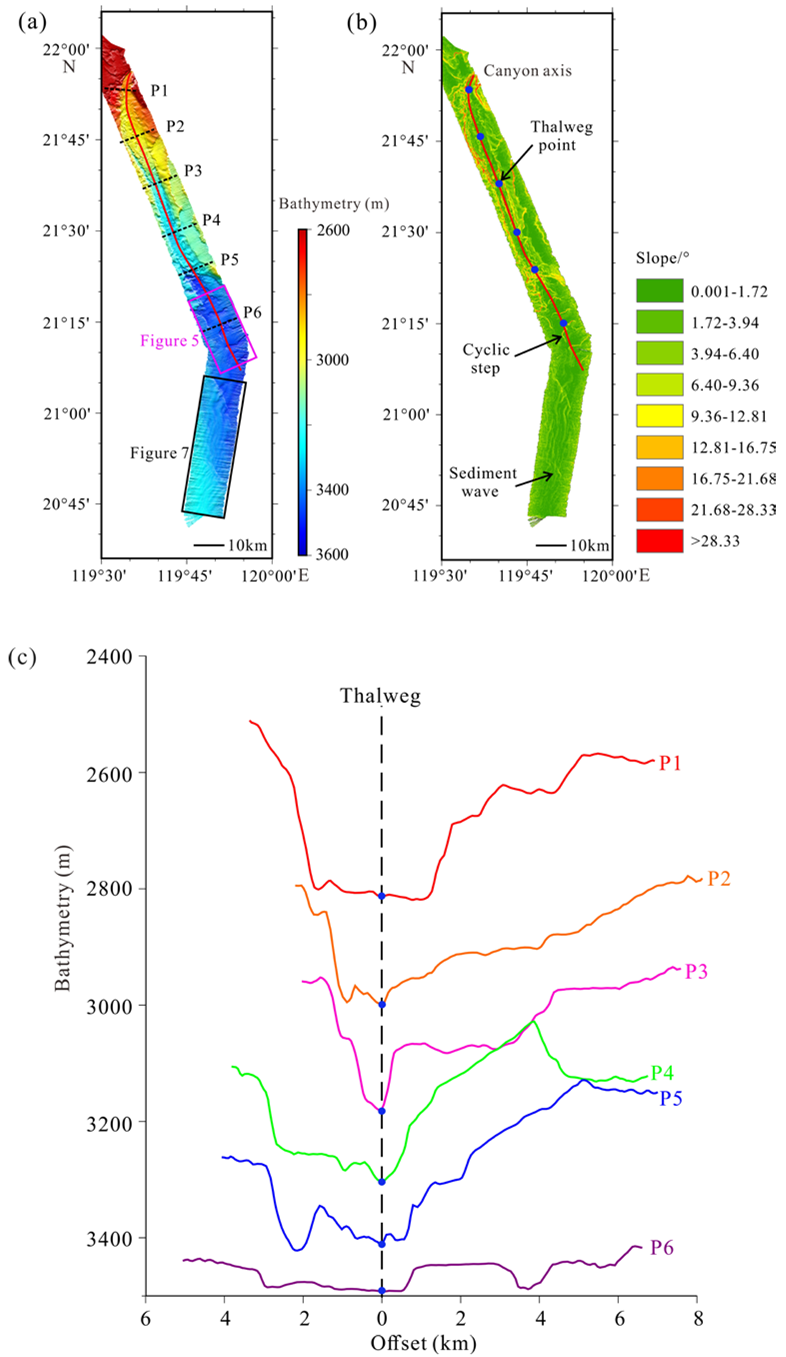
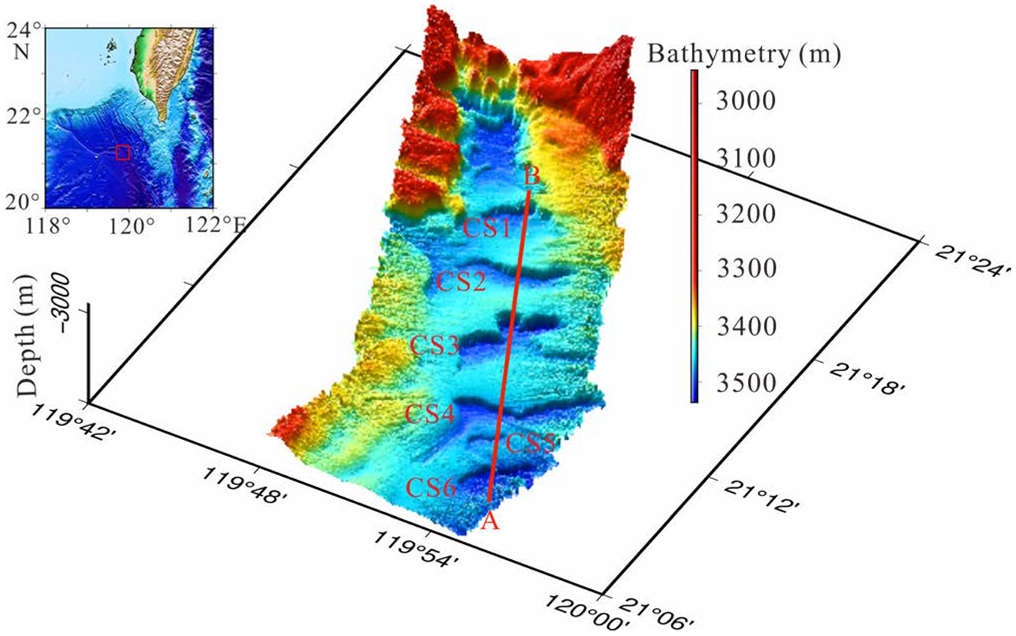
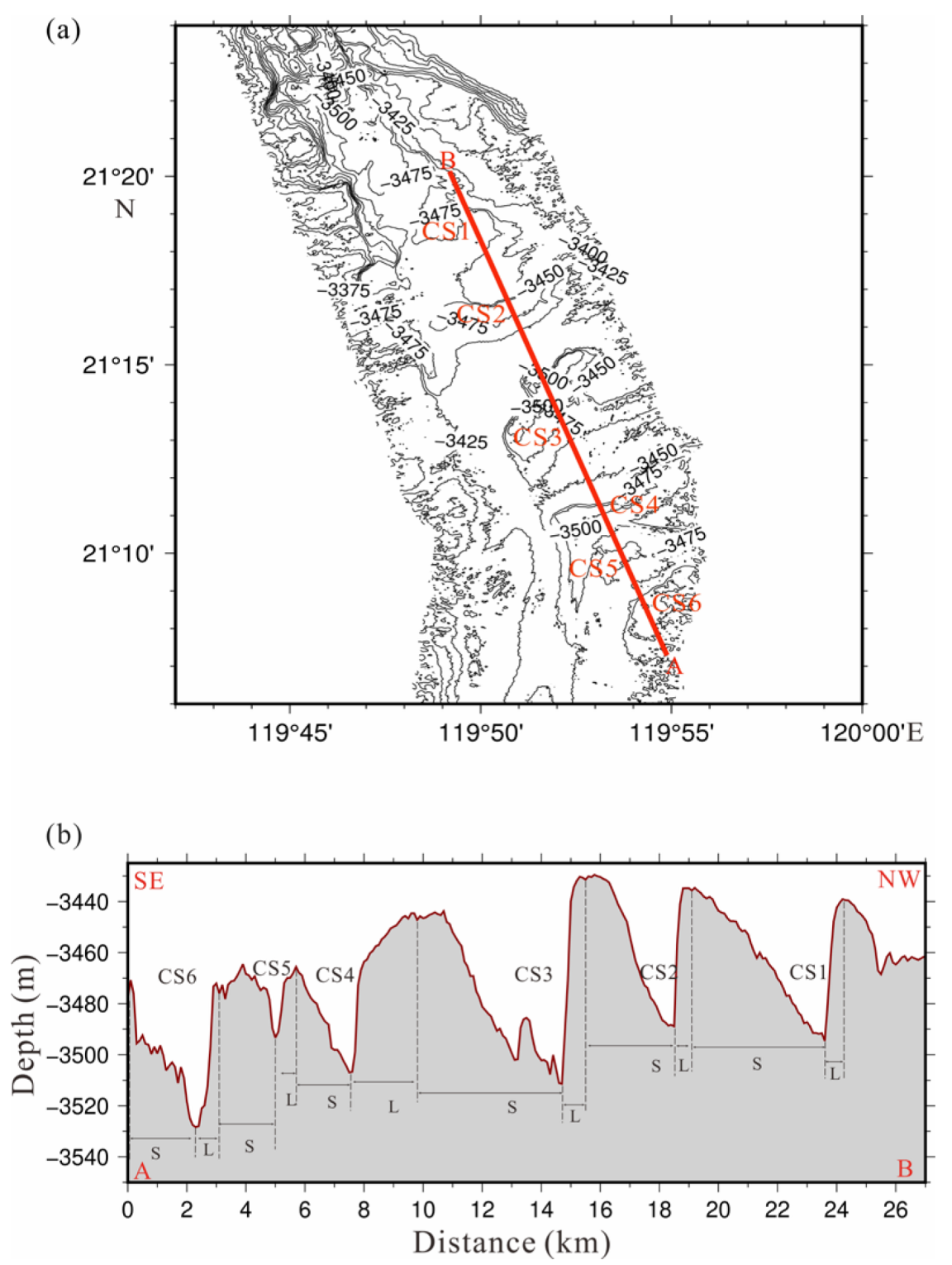
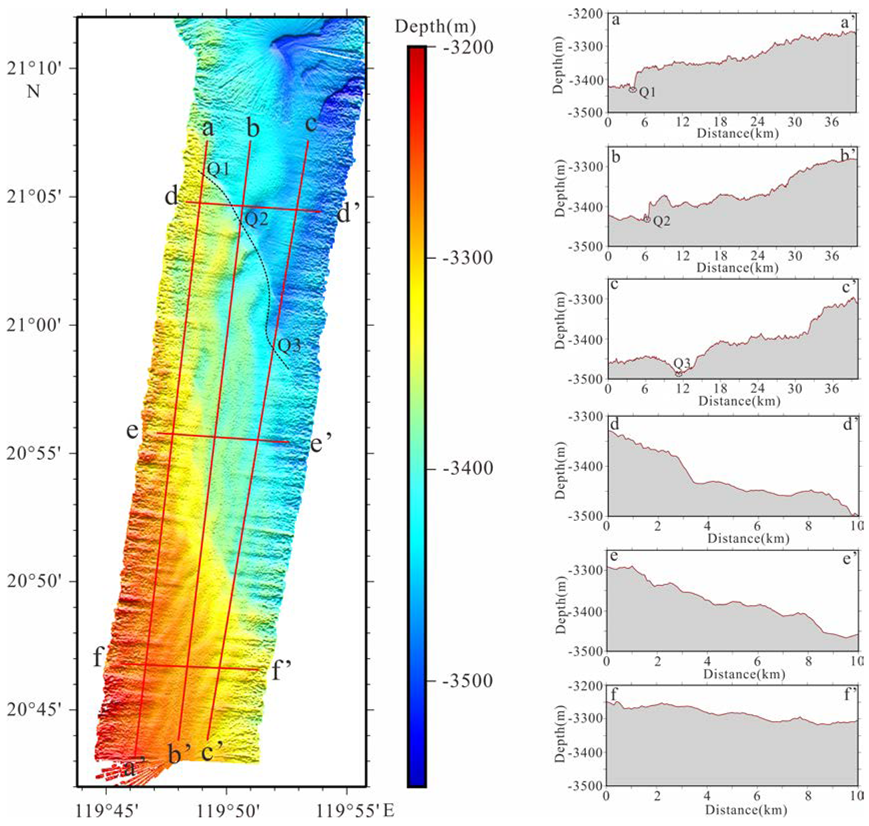
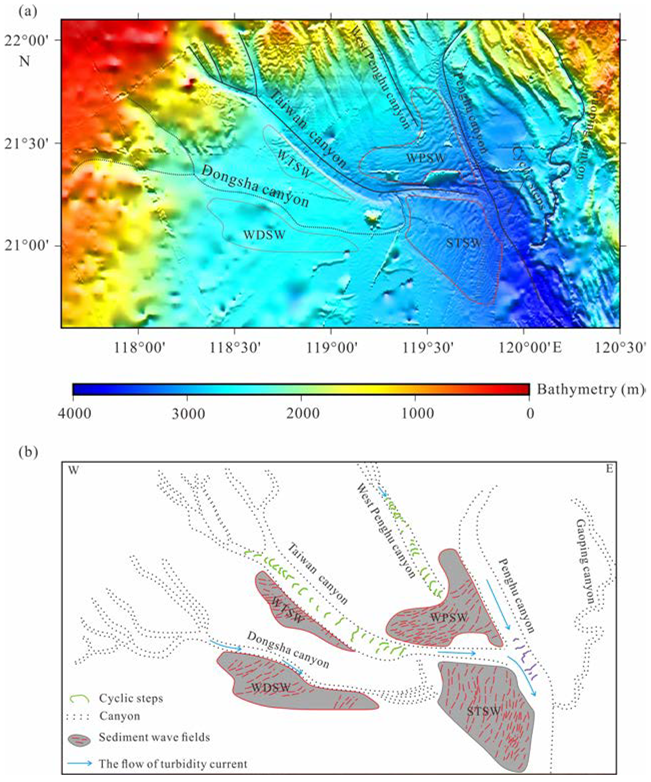
| Type | CS1 | CS2 | CS3 | CS4 | CS5 | CS6 |
|---|---|---|---|---|---|---|
| Wavelength/km | 4.16–5.37 | 3.25–3.98 | 5.00–5.86 | 3.14–4.32 | 1.28–2.67 | 2.76–3.09 |
| Wave height/m | 45.13–60.76 | 40.02–58.11 | 77.88–80.95 | 60.30–61.21 | 19.10–29.93 | 44.35–61.11 |
| Area/km2 | 4.27 | 7.08 | 11.01 | 11.77 | 0.89 | 4.95 |
| Lee-side length/km | 0.61–1.29 | 0.33–0.86 | 0.59–2.27 | 1.83–2.07 | 0.31–0.68 | 0.70–1.38 |
| Stoss-side length/km | 2.88–4.73 | 2.39–3.22 | 3.59–5.26 | 1.31–2.20 | 0.84–1.98 | 1.70–2.17 |
| Lee-side slope | 0.05–0.09 | 0.07–0.17 | 0.08–0.14 | 0.02–0.03 | 0.03–0.05 | 0.04–0.08 |
| Stoss-side slope | 0.01–0.02 | 0.01–0.02 | 0.01–0.02 | 0.03–0.05 | 0.01–0.02 | 0.03–0.04 |
| Overall slope | 1.29 | 1.08 | 1.60 | 1.09 | 1.16 | 1.11 |
| Aspect ratio | 68.49–102.99 | 55.84–99.50 | 64.20–72.35 | 52.12–70.49 | 62.58–119.69 | 50.69–62.14 |
| Asymmetrical index | 0.13–0.45 | 0.10–0.36 | 0.11–0.63 | 0.94–1.39 | 0.16–0.51 | 0.32–0.81 |
| Type | Shenhu Canyon | Penghu Canyon | Taiwan Canyon | West Penghu Canyon |
|---|---|---|---|---|
| Constructed | Deposition-based | Exploitation-based | Exploitation-based | Exploitation |
| River | Pearl River | None | Hanjiang | None |
| Canyon Type | river-associated, shelf incising canyon | shelf incising canyon | river-associated, shelf incising canyon | shelf incising canyon |
| Canyon head slope | 1.96–2.88° | 5–12° | 3–12° | 7–13° |
| Bathymetry | 700–1600 m | 2100–3000 m | 200–3500 m | 400–3000 m |
| Control Factors | Combination of turbidity flow, landslide and debris flow | Tectonic and turbidity currents | NW-oriented paleo transformation faults, magmatism and turbidity currents | Tectonic and turbidity currents |
| Continental Edge Type | Passive Continental Edge | Active Continental Edge | Passive Continental Edge | Passive Continental Edge |
| Canyon length | 30–60 km | 180 km | 150 km | 90 km |
| Sediment type | silt and clay | Sand | Sand | Sand and mud |
Publisher’s Note: MDPI stays neutral with regard to jurisdictional claims in published maps and institutional affiliations. |
© 2022 by the authors. Licensee MDPI, Basel, Switzerland. This article is an open access article distributed under the terms and conditions of the Creative Commons Attribution (CC BY) license (https://creativecommons.org/licenses/by/4.0/).
Share and Cite
Zhang, S.; Zhu, J.; Jia, Y.; Li, S.; Chen, R.; Chen, X.; Ou, X.; Li, Q. Submarine Small-Scale Features of Cyclic Steps in the Penghu Canyon: Implications for the Migration of Canyon. J. Mar. Sci. Eng. 2022, 10, 1301. https://doi.org/10.3390/jmse10091301
Zhang S, Zhu J, Jia Y, Li S, Chen R, Chen X, Ou X, Li Q. Submarine Small-Scale Features of Cyclic Steps in the Penghu Canyon: Implications for the Migration of Canyon. Journal of Marine Science and Engineering. 2022; 10(9):1301. https://doi.org/10.3390/jmse10091301
Chicago/Turabian StyleZhang, Shaoyu, Junjiang Zhu, Yonggang Jia, Sanzhong Li, Ruixue Chen, Xingquan Chen, Xiaolin Ou, and Qianqian Li. 2022. "Submarine Small-Scale Features of Cyclic Steps in the Penghu Canyon: Implications for the Migration of Canyon" Journal of Marine Science and Engineering 10, no. 9: 1301. https://doi.org/10.3390/jmse10091301
APA StyleZhang, S., Zhu, J., Jia, Y., Li, S., Chen, R., Chen, X., Ou, X., & Li, Q. (2022). Submarine Small-Scale Features of Cyclic Steps in the Penghu Canyon: Implications for the Migration of Canyon. Journal of Marine Science and Engineering, 10(9), 1301. https://doi.org/10.3390/jmse10091301







